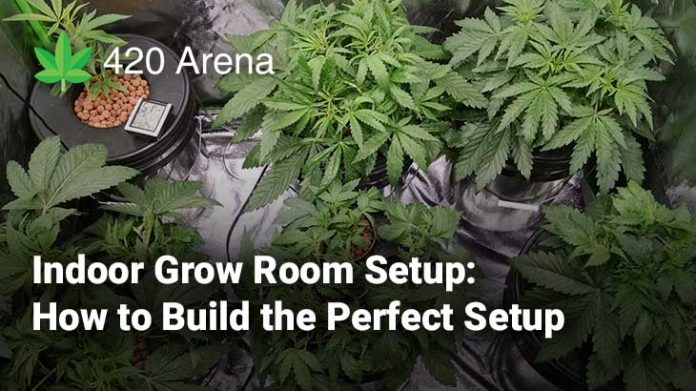Growers, over the years, have debated and discussed as to which is the best way to grow their weed. Should it be grown indoors or outdoors, should it be grown in tents or cabinets or rooms? There’s just so many questions and we’re still finding out answers about which is the best way for growing a plant that has been in use for thousands of years! In this article, we talk about the indoor grow room – and how to set it up, how to build the perfect indoor grow room for all your marijuana growing needs.
Over the course of this article, we understand what a grow room is and why it is important to have one for your weed growing needs. Then, we move on to the indoor grow room setup and take a look at all the things that need to be kept in mind when you are setting up an indoor grow room for growing cannabis indoors!
What is a Grow Room? Why Do You Need One?
Broadly speaking, there are two ways in which weed can be grown – out in the nature under the open skies, or under a controlled environment indoors. Growing your weed outdoors has a number of problems such as the weather going bad, too much rain, snow, etc. hindering the growth of your plants. There’s also the possibility of insects and pests which can destroy the plants in no time! Moreover, despite weed getting legalized in many places, it continues to be a social taboo. With all these reasons combined, people prefer to grow weed indoors.
Growing weed indoors has a number of benefits as it allows you to provide just the perfect growing conditions for your plant. You can adjust the heat and light to the right levels, provide adequate water to the plants, give them nutrition, and even tweak the basic elements in a way that the plants provide an optimum output.
When you grow your weed indoors, there are multiple options that you have – you can either set up grow cabinets, or grow tents. However, setting up a grow room is one of the best ways to grow your cannabis plants, especially if you are planning to grow a lot of them and want to provide the maximum possible attention and care to the plants. A grow room is a room which has been modified by the grower in order to provide almost a replica of natural resources such as light, heat, water, humidity and air – elements that are required for the proper growth of a marijuana plant.
While setting up a grow room is a tedious process, but once it is done, you’ll be really happy with the end product that you get once the harvest season begins. Let us now take a closer look at how to set up an indoor grow room.
Indoor Grow Room Setup: How to Build the Perfect Grow Room for Your Cannabis Plants?
Now that you have understood the differences between growing weed indoors vs growing weed outdoors, as well as the need for a grow room and why it is important for growing marijuana, let us now take a closer look at how to set up a proper grow room and what are the steps that need to be carried out while building a grow room.
- Creating a Blueprint
This is the first and the most basic step that needs to be carried out before you begin to set up your grow room. Creating a blueprint is basically creating a plan of what you have in your mind down into a piece of paper. Before you go ahead with setting up the stuff in your grow room, you need to visualize it in your mind’s eye and when you actually chalk it down, you would realize if there are any flaws in what you have envisioned. If there are, you can rectify them and then begin the setup. This is always better than finding out that something’s amiss after you’ve set up the grow room and then have to re-do things to incorporate these changes.This will also help you determine the amount of space you have (usually in square meters) and also help you determine the amount of plants that you can arrange in this space.
- Cleaning
After preparing the blueprint, the first thing that needs to be done is the cleaning of the floor. This is very important for setting up a grow room. The cleaning process involves multiple steps – you need to remove all the furniture that is lying around, plus you need to make sure that the room is free of any dust and debris that might have gathered around, because this is something that is counterproductive to the growth of your plants. Once you have cleaned the area, you also need to disinfect it with the help of something like a Lysol or any similar alternative. We strongly suggest that you remove carpets and drapes from the room because they tend to gather a lot of dust and germs.
Cleaning might be something that you find a little hard to do, but this needs to be done because any bacteria, germs or insects that might be around are dangerous because they can destroy your plants in no time! Hence cleaning needs to be intense. Not only do you need to clean the room before you set up the grow room, but you also need to clean it up after you’ve set it up because a lot of dirt would again be lying around just after setting it up!
- Preparing the Floor
Up next is the process of flooring. The floor needs to be ‘prepared’ in order for the grow room to be set up. This basically involves setting up plastic sheets on the floor which will make sure that any water that gets spilt on to the floor remains on the sheets and does not percolate through into the floor, where it can lead to accumulation and give rise to insects/etc. It is advised that one must make use of white plastic while doing so because that helps in the reflection process (which will be dealt with in detail in the next point).
The floor needs to be layered with plastic sheets well because while most people think that they will be careful while watering the plants, the fact is that there are a lot of spillages as well as water leakage involved in growing marijuana and you are bound to spill some water on to the sheets. Make sure that you mop off the water from the sheets if and when it falls.
- Deciding on the Reflective Surface
This is another important aspect of setting up the grow room. You need to decide on a proper reflective surface. We can’t stress enough on why this is so important because reflective surfaces are the ones which have a huge role to play when it comes to growing your weed in an effective and efficient manner. Before we head into the details about reflective surfaces, here’s why they are important: reflective surfaces help you in many ways. They help you to maximize the efficiency of your light by bouncing it off the walls and into your plants. They also help you reduce the costs as you can provide maximum possible light with the help of these surfaces. Another advantage of having reflective surfaces (in the lower portions of the room) is that they will help the lower portions of the plants to bloom well, which might get covered under thick vegetation sometimes and do not get enough light.
All areas of a grow room must be covered with a reflective surface which will allow the light to keep bouncing back. However, before anything else – PLEASE DO NOT USE A MIRROR. Avoid using tin foils as well. While most of us consider a mirror to be a very ‘reflective’ surface, one also needs to understand that mirrors tend to absorb light and they can be quite counterproductive. Here are some surfaces that you can actually use to set up your grow room:
- Mylar
- Foylon
- Flat White Paint
- Poly Plastic (Black or White)
- Elastomere (rubberized) paint
- Styrofoam
- C3 Anti-Detection Films
- Emergency Blankets (also known as Space Blankets)
Notes:
- While using plastic, make sure it is not too close to the light source because it can actually melt if there’s too much heat.
- While using paints, ensure that you are putting in a coat of fungicide on top of that to avoid any possible fungus.
- Setting up the Lights, Heat, Humidity, Water and Ventilation Systems
Now we come to another important part – the one which actually deals with the basic elements: Light, Heat, Water and Air. These are the four critical elements that your plants need to grow. While they exist in nature if you decide to grow them outdoors, but for growing them in an indoor grow room, you need to replicate them with the help of grow lights, a watering system and a proper ventilation system. Here’s a closer look at each of these elements:
-
- Lights: Depending on the kind of plants that you want to grow, you need to decide the kind of grow lights that will be the best for your plants. In case of growing cannabis indoors, we recommend using full-spectrum LED grow lights which have a switch that can change the lights from ‘vegetative’ mode to ‘flowering’ mode, meaning that you can use the same grow lights for both the phases of growth and you do not have to change it again and again. Hanging the grow lights is also quite a challenge and you need to make sure the distance is just right and that you have made use of proper equipment to hang it so that the lights remain firm and stable and do not fall down. Also check if the lights are equally balanced. Lastly, make sure you’ve hung it at an appropriate distance from the top of the plants so that the heat doesn’t burn out the plants.
- Water: In case of setting up the water systems, we would recommend using a 150L barrel that can be placed at a distant corner of the grow room. Fill it by about 50L with fresh water and use a water pump and connect a hose (with a spray nozzle) with the pump. You will also need a circulation pump that will allow you to mix water and the nutrients well. Also make sure that the barrel of water that you are using has a lid on top of it. It will ensure that the water does not evaporate and add to the humidity of the room.
- Air/Ventilation: The simplest (although not the most effective) way in which you can provide air circulation is with the help of simple household fans. However, in order to ensure that your plants are getting fresh air and that the stale air is being taken out, we strongly recommend the use of extractor fans.The room also needs to have at least one (or multiple) vents so that fresh air can enter the room and stale air can exit the room. Air is also important for the growth of the stem. If you generate a light breeze around the plants the stem will grow sturdier. Lastly, you can also (optionally) set up a CO2 Pump which can provide Carbon DiOxide to the plants, which is great for photosynthesis. Get a generator with a regulator for this purpose but make sure you don’t overdo this.
- Humidity: Humidity is another very important factor that helps promote the growth of the marijuana plant. Plants need humidity in the air so that they can directly absorb the water from the vapor on to their leaves with the help of little openings called stomata. When the humidity levels are high, water intake happens more via the leaves and less via the roots and this is a good way to provide adequate water to the plants during the vegetative stage. However, during the flowering stage, when you need to provide nutrients to the plants, you can reduce the humidity so that more water is taken via the roots and the nutrients also go in with that. Humidity can be controlled with the help of humidifiers and dehumidifiers, and you need to set them up in the room to ensure that the plant’s humidity needs are catered to.
- Temperature Control: A temperature of about 65 to 75 degrees Fahrenheit is good for the growth of plants in general. However, at different stages of growth they require different levels of heat. Remember that the growth slows down in colder temperatures and the plants get worn out if too much heat is provided. Hence an ideal temperature needs to be maintained. This can be done with the help of proper air circulation, proper watering and setting up an appropriate distance between the light and the plant! For best results, an independent heating/cooling system needs to be set up for the grow room.
- Potting and Planting: The next step is potting and planting – which is the last step in the process of setting up a grow room. Set up your pots, fill them with soil and begin planting your marijuana!
- Lights: Depending on the kind of plants that you want to grow, you need to decide the kind of grow lights that will be the best for your plants. In case of growing cannabis indoors, we recommend using full-spectrum LED grow lights which have a switch that can change the lights from ‘vegetative’ mode to ‘flowering’ mode, meaning that you can use the same grow lights for both the phases of growth and you do not have to change it again and again. Hanging the grow lights is also quite a challenge and you need to make sure the distance is just right and that you have made use of proper equipment to hang it so that the lights remain firm and stable and do not fall down. Also check if the lights are equally balanced. Lastly, make sure you’ve hung it at an appropriate distance from the top of the plants so that the heat doesn’t burn out the plants.


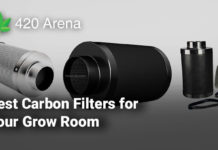
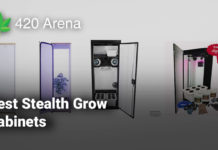
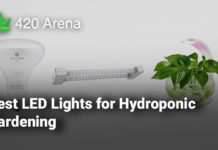








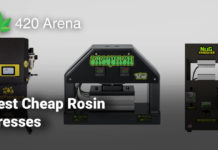
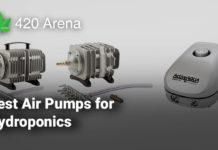
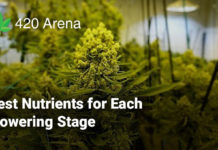
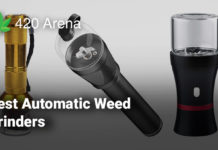
![How to Use Carbon Filters in Your Grow Room [7 Best Carbon Filters for Grow Rooms in 2021] How to Use Carbon Filters in Your Grow Room](https://420arena.com/wp-content/uploads/2020/12/How-to-Use-Carbon-Filters-in-Your-Grow-Room-218x150.jpg)





